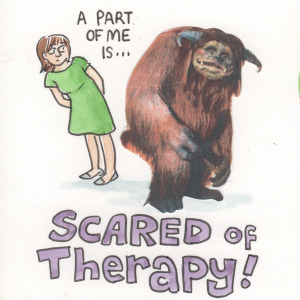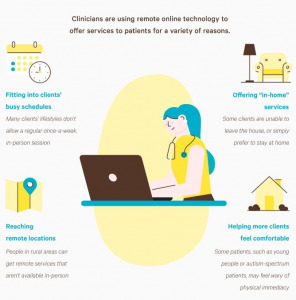If you asked me what I ate for dinner last night, I’d probably stare at you blankly and fumble to recall the specific DoorDash delicacy – was it gorgonzola gnocchi from that mom-and-pop shop down the street, or did I splurge on my favorite salmon and avocado sushi?
I honestly can’t remember.
But I’ll never forget the timing of my “firsts” throughout the years – the timing of my first kiss (it happened in the 5th grade, to a garrulous boy named Chris), the timing of my first rock concert (I was an angsty high-school freshman with a musical crush on Moby), and the timing of my first skydive (I was a brand new college graduate with a massive thrill-seeking streak).
I remember, too, the timing of my first-ever therapy session: I was a month away from turning 30, though I’d struggled with depression for years.
The timing of this “first” is the one that surprises people the most, because I’m now a fervent mental health evangelist. Heck, I even majored in psychology, then studied clinical counseling in grad school. Still, I let the wounds of my own psyche fester for far longer than was healthy, until my bruised-up brain was writhing and crying out for help. Why in the world had I let it go for so long?
The answer was quite simple: I was really freaking scared.
No matter who you are, the first time you try something always comes with a certain fear. Many times, the unknown is both scary and exciting, a familiar blend of emotions that brings butterflies to the chest. But when that unknown involves sitting face-to-face with a stranger to spill the secrets of your deep-seated trauma, there are no pleasant butterflies – just an overwhelming queasiness, an impending sense of doom. In my case, it seemed safer to navigate the darkness by myself, curled up stoically under my weighted blanket – not setting myself up for a clinician’s stern judgment on unfamiliar turf.
So, I resolutely avoided therapy. Instead, I scoffed at the notion and pressed forward on my own, until I finally became so broken that I collapsed into pieces – right on a therapist’s couch.
This was nearly a decade ago. Back then, if you wanted to see a mental health professional, you usually had to pull yourself together and attend a session in person. But when your sadness runs so deep that climbing out of bed is a Herculean task, showing up to an appointment feels like several steps too many. For that reason, many of us who needed therapy never made it to our first session, because the barriers seemed insurmountable.
Fortunately, much has changed since then. In today’s post-pandemic world, most people have the option to pursue online therapy as an alternative to face-to-face treatment. If you’re struggling with your mental health but hesitant to attend sessions in person, online therapy can offer you the opportunity to “see” a professional from the comfort and safety of your own home (yes, even cocooned in your own bed if you’d like).
Curious to learn more? We asked practicing mental health experts to help us break down the basics of online therapy, including what it is, who can benefit, and how you can get started with your own online therapist.
What is Online Therapy?
Online therapy, or teletherapy, is therapy conducted remotely via video conferencing, email, live chat, or telephone. And believe it or not, “Teletherapy existed prior to the pandemic,” says Ciara Helm, L.C.S.W., a therapist in private practice who offers online sessions. In fact, psychologists have been studying the effectiveness of teletherapy since the 1960s, she points out.
The results of this dedicated research? Even more promising than expected. “Teletherapy is not only more accessible; it is convenient and proven to be just as effective as in-person therapy for clients,” Helm explains. Indeed, a 2017 review found that Internet-delivered therapy produced “equivalent overall effects” to face-to-face treatment, and further research showed that clients were more likely to complete their treatment if it was administered online.
#Teletherapy is the biggest revolution in mental health care since switch from hospital to office practice 100 yrs ago.
More than 90% visits are now virtual.
I predict will permanently replace most face-to-face contact even after pandemic is under control.
Convenient/Effective https://t.co/KcMxLx9uNY
— Allen Frances (@AllenFrancesMD) July 11, 2020
While the study of online therapy has been ongoing for several years, “this form of therapy exploded once the world was ordered to stay home [during the Covid-19 pandemic],” Helm says. When in-person interactions suddenly screeched to a halt, clinicians and their clients had no other option than to conduct therapy sessions remotely – thus, online therapy blossomed into the new norm.
What Are The Advantages Of Online Therapy?
Even as many in-person practices have reopened for business, online therapy continues to convey certain advantages over face-to-face treatment. Here are some of the biggest benefits, according to the experts:
-
Accessibility. With online therapy, “there is no need for long commutes or sitting in waiting rooms,” explains Sari Fleischman, Psy.D., a licensed psychologist who runs an online practice. “Seeking an online therapist opens up access to those living in remote areas or who are looking for someone with very specialized training who lives in a different part of the state or country.”
-
Comfort. For many people, “being in the comfort of a safe environment makes it easier to talk about difficult topics more quickly, which can lead to faster change,” Fleischman says. Plus, it may feel less intimidating for a client to open up over a computer screen rather than in person.
-
Flexibility. “Scheduling is typically easier because appointments do not require commute time,” says Brian Jones, M.Ed., L.M.H.C., a licensed mental health counselor with an online practice. “Many of my clients are able to meet online with me from work, and they have an agreement with their employer to take the same hour every week for our appointments.” Online therapy also is an ideal option for people with young children, as it can eliminate the need for childcare.
-
Cost. For people paying out-of-pocket, online therapy is often more affordable than in-person sessions.
Who Is (And Isn’t) A Candidate For Online Therapy?
Feeling tempted by teletherapy but not sure you’re a candidate? Good news: You probably are. “My experience has been that a broad spectrum of clients would benefit from this type of therapy,” explains Helm. “I have had the honor of meeting with mothers at home with their infants, couples who have traveling partners, business professionals on a tight schedule, and recluse clients. Most people would benefit from teletherapy,” she says.
“Online therapy has been found to be as effective as in-person therapy, and it would be recommended for most people seeking services,” agrees Erin Dierickx, L.M.F.T.A., a licensed marriage and family therapy associate. There are just a few exceptions, she says, when online therapy should not be used to replace in-person treatment: situations in which the client is at high risk due to severe symptoms or circumstances.
“Times in which it may not be appropriate include if a client is experiencing domestic violence and their privacy is at risk during sessions in order to process the experience and safety plan,” Dierickx explains. “Other instances include when an issue is severe enough to require in-patient services such as severe eating disorders, suicidal ideation where intent and plans are in place, or addiction requiring treatment.” (If you’re in crisis or feeling suicidal, call or text the National Suicide Prevention Lifeline at 988 immediately).
The 988 Suicide & Crisis Lifeline is now live! If you or someone you know is experiencing mental health or substance use-related crisis, call or text 988, or chat https://t.co/EiVLtZjvdX #988Lifeline pic.twitter.com/vEr4gKfy5k
— Miriam E. Delphin-Rittmon, Ph.D. (@SAMHSA_Leader) July 16, 2022
How Do I Get Started With Online Therapy?
Ready to take the plunge and explore teletherapy? Before you dive headfirst into the major online platforms (think Betterhelp or Talkspace), caveat emptor: Many mental health experts actually recommend against these services.
“Most of the major online therapy platforms are tech companies pretending to be health companies, and they are often predatory and misleading in their advertising,” Helm explains. “For instance, some may offer ‘free therapy,’ but it’s only for a month, which is not enough time for most therapy to be effective.
“After that, if the client can’t afford to continue, they lose their therapist,” she reveals. These platforms also have a reputation for selling user data, she says, which is troubling for clients who are already hesitant about therapy due to confidentiality concerns.
Felt this was #important so I’m reposting this thing I saw on tumblr
Link: https://t.co/nOuVepvjCI
.#betterhelp #betterhelpscam #pridecounseling #mentalh #mentalhmatters #onlinetherapy #scam pic.twitter.com/zcmeNd0SZA— Souls / Lunar (@withered_s0uls) July 25, 2022
Furthermore, “some of the larger companies marketing online services have a reputation of having high productivity expectations for their clinicians, which could lead to therapist burnout and impact quality of care,” Fleischman adds. For these reasons, the best approach is to seek online therapy from a small private practice, not from the large conglomerates.
To get started, search the directory at HelpPRO or Psychology Today for an online therapist who meets your needs. You can filter results by demographics, therapeutic modality, specialty/area of expertise, and cost/insurance plans. For more information on choosing a therapist, read our articles on what makes a good therapist and when to break up with your therapist.
And if you’d like to try out therapy but prefer the old-school way – in-person sessions – remember that that’s okay, too. You can even dabble in the best of both worlds by following a hybrid model.
“Technology is here to stay – but most of us are unable to live a life fully online or offline,” says Matteo Marin, a therapist at an integrative practice. “If you are unsure what works best for you, integrating the online and the offline world might be an excellent way to go about that. Maybe working with a therapist who can welcome you both online and offline can answer your needs.”

Have you ever attended online therapy? Was it effective? Let us know in the comments!
If You Liked This Article, Keep Reading Below:




